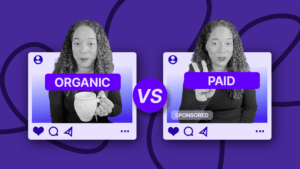Unshackling Your Online Voice: How UGC Software Can Amplify Your Brand
With over 7 years of e-commerce experience, Agne has mastered the balance of creativity and performance. From guiding social media strategies to crafting high-converting ads, she’s all about results.

Brands know that user-generated content (UGC) is the future. Influencers and online creators seem to have a unique ability to generate sales opportunities, brand loyalty, and engagement that in-house marketing teams can’t match.
But, of course, managing these social media personalities is challenging. There’s a lot of admin involved.
That’s where UGC software can help. It provides various tools to source, collect, and moderate UGC (along with all the usual analytics you get on modern software packages). Using it can yield considerable time savings and protect against unsuitable or illegal content.
Are you considering using UGC software in your company? If so, this guide is a must-read. We discuss the various UGC software available and how to choose a solution that suits you. You’ll learn how to implement packages in your firm and the best practices for lasting success.
But first, what’s out there?
UGC Software: What’s Out There?
UGC management software comes in various forms. Most of it helps you save time. But it can also improve outreach, boost campaign return on investment (ROI), and improve compliance.
Content Aggregation Tools
The most common software type is UGC aggregation tools. These take UGC from various sources and dump it into a single dashboard for your perusal.
Most content aggregation tools, like Tint and Stackla, have advanced search functionality and filters. These let you skim for specific hashtags or eliminate influencers except those in your target region.
Be warned though: run-of-the-mill content aggregation tools can be rudimentary. While you can search by keywords, limited filtering options mean it can take a while to find influencers in your niche.
Moderation and Curation Platforms
Moderation and curation platforms are a step up from rudimentary aggregation tools. These collate content and filter out harmful or unhelpful influencers.
Advanced software, like SmartModeration, lets you customize the moderation standards your firm expects. Then, the software filters out anything that doesn’t conform to your standards.
For example, AI-driven features can eliminate spam, nudity, violent content, and unwanted speech. These mechanisms ensure content is safe for your audience and does what you want it to do.
Sometimes, you can also automate curation, getting tools to put UGC into categories based on theme, product, ad, or topic. These AI features are incredibly helpful when you want to identify user content that makes sense for a specific campaign or feature. Curalate and Yotpo or two good examples.
Analytics and Reporting Tools
Lastly, you can also get UGC software to help with analytics and reporting. Solutions can track things like:
- Audience engagement levels (the likes, shares, and comments an influencer generates)
- Reach (the number of unique users viewing content)
- Impressions (the total number of user views)
- User sentiment (how they feel towards the influencer and your brand)
- User demographics (the age, gender, and other personal characteristics of users)
- Platform-specific performance (the channels generating the most engagement for your campaigns e.g. X, Facebook, Instagram, etc.)
- UGC campaign performance metrics (such as number of sign-ups or views)
- Content scoring tools (helping you figure out which content is likely to land strongest with your audience)
- Follower growth (how many people are following your influencers and the level of engagement they’re generating)
Don’t underestimate the value of these reporting tools. Real-time dashboards can help with everything from which influencers to work with to how much you pay them.
How Do You Choose the Right UGC Software (And Avoid Making Costly Mistakes)?
Choosing the right UGC software isn’t always straightforward. As we have seen, solutions can vary significantly.
Factors To Consider
The trick here is to select packages with the features you need. Your requirements may be different from the average brand.
Ease Of Use
The first factor to consider when choosing UGC software is ease of use. Staff shouldn’t face a steep learning curve.
The best UGC software reduces menu options and increases the use of AI to provide users with what they want. Staff can prompt these solutions with natural language instead of fiddling around in settings.
Onboarding
Onboarding should also be a part of the offering. Vendors should provide employees with instructions, training, and support if they get stuck. To make this more effective, mentoring software can offer employees expert guidance and skill development from day one.
Integration Capabilities
Integration capabilities may also be valuable for companies with extensive software stacks. Combining features simplifies processes and prevents staff from flipping from one app to another. As such, social media integration is a top priority, helping to manage content across platforms, and reducing errors. Shopping channels and ecommerce integrations can also help. These support your brand if you operate an online store and want to curate reviews and case studies.
Content Moderation
Content moderation is another essential feature. Look for tools with AI-driven systems that can flag content for you to review.
Also check the software has compliance-related features, such as detecting plagiarism or copyrighted material. These features can prevent lawsuits if you use UGC in your marketing.
Reporting
Finally, look for reporting features. Choose software that offers analytics that matters to you, including return on investment (ROI).
How Do Top UGC Tools Compare?
UGC tools can vary significantly from each other. For this reason, it always pays to take your time before picking one product over another.
For example, Tint is popular for UGC aggregation, letting brands collect user-generated content from multiple channels. By contrast, Yotpo focuses more on collecting reviews and ratings for e-commerce stores.
Curalate is another popular option. It helps brands pick the best UGC for more “shoppable experiences” while Bazaarvoice concentrates more on review management.
How To Implement UGC Software Effectively And Get Your Team Onboard
Implementing UGC software effectively and getting your team on board can be challenging. However, with the right approach and training, you can make it easier.
To integrate software effectively:
- Select UGC software that makes sense for your business model (i.e. whether you sell via an ecommerce store or offer professional services)
- Plan your integration process by outlining a plan for the software you will integrate
- Assign roles and responsibilities (and ensure the people on your team have the necessary skills to perform the integration)
- Integrate UGC software with your website (if you plan to display UGC on product pages or service portals)
- Integrate UGC software with your social channels (to automate posting or monitor content)
Two Best Practices for Using UGC Software
Using UGC software isn’t always straightforward and you can make mistakes. Therefore, always adopt the best practices and strategies, copying what’s worked before.
Automate UGC Collection
Start by using tools to automate UGC collection. Don’t waste time doing it yourself.
High-quality software solutions let you set up automated filtered and keyword blacklists to curate content. These reduce your candidate content list substantially, cutting down on content selection time.
You can also use geo-tagging techniques that let you collect UGC from specific regions. These are helpful if you run a local company and only want to reach out to a local audience.
Use Analytics To Boost Campaign Performance
You also want to use analytics to boost performance. For example, you could leverage:
- Engagement levels to track likes, shares, and comments
- Sentiment trends to understand the wider perspective on your brand
- Conversion rates to determine whether awareness is translating into sales
- Content themes that attract the largest audiences
- Reach relating to specific influencers to monitor value-for-money
Only choose metrics that matter to your brand. You don’t need to track all of them.
Successful UGC Software Use Cases: Companies That Nailed It
That’s enough of the abstractions. Let’s take a look at examples of companies successfully using UGC software to nail their marketing campaigns.
1. Glossier
Glossier is a make-up and beauty brand with a minimal aesthetic and cult-like following. It understands the power of UGC and uses it across its advertising, driving social media success.
The brand, founded in 2014, immediately took a community-driven approach to its outreach from the outset. It encouraged customers to share their experiences with its products with their peers, and leveraged UGC software to curate the user-generated content it selected for its campaigns. Content making it onto its social media pages was best fit for its aesthetic and values. Everything else was filtered out.
2. Starbucks
Starbucks took a slightly different approach from Glossier but also saw massive success in its UGC effort. Its #WhatsYourName campaign asked customers to produce short stories about their identity and where they came from, tying in with the brand’s habit of writing customers’ names on cups.
The campaign was particularly effective at appealing to people concerned about inclusivity in the LGBTQ+ community. Drawing attention to identities helped Starbucks align its values with its customer base.
3. Nike
Finally, Nike is also a user of UGC software, leveraging it across several campaigns throughout its illustrious history. In one example, it used it in its Nike+ app to showcase its users’ routines and achievements. The result was an inspirational campaign that chronicled success stories, motivating others to get fit and buy its products.
The primary consequence of the campaign was a reinforcement of Nike’s brand value. It helped audiences view the company as a supporter of health and athletic achievement.
Furthermore, it also encouraged more individuals to get involved in the brand directly. Instead of simply going to the store and buying the company’s products, consumers were also talking about them.
Looking to generate UGC video content? Check out Billo’s 5000+ vetted creators to jump-start UGC campaigns.
Creative Manager
With over 7 years of e-commerce experience, Agne has mastered the balance of creativity and performance. From guiding social media strategies to crafting high-converting ads, she’s all about results.

Authentic creator videos, powered by real performance data
22,000+ brands use Billo to turn UGC into high-ROAS video ads.
Common UGC Brief Mistakes Brands Still Make in...
A vague or overpacked brief derails campaigns before they start, [...]...
Read full articleOrganic UGC vs Paid UGC: How Top Brands Drive Gr...
More brands are turning to user-generated content (UGC) to fuel [...]...
Read full articleOrganic UGC: How to Turn Native Creator Posts in...
Short-form feeds spotlight content that feels natural, not like ads. [...]...
Read full article



